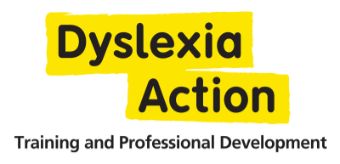Specialist Teacher Training Programmes: Back to the Future in Literacy Development
Lucy Howes
Specialist teacher training is much more than an understanding and management of dyslexia and literacy, diversity and inclusivity in learners. Qualified specialist teachers will have had access to a specific literacy programme.

These programmes will have provided a thorough training in the phonology and phonetics of the English language and a sound underpinning knowledge of language acquisition, morphology and syntax, semantics and the sociological dynamics of language. Knowledge that is informed by speech and language and communications therapies is built into comprehensive training courses that enable the practitioner to address the diverse literacy needs of any individual and provide appropriate remedial training. The Dyslexia Actional Literacy Programme (DALP) is one of these programmes.
The Dyslexia Action Literacy Programme
The Dyslexia Action Literacy Programme (DALP) began development in 2012 as a response to the emerging new specialist postgraduate teacher training programme (a radically different content to previous courses) that Dyslexia Action Training had launched and in the context of the post ‘Rose Review’ environment. DALP is a flexible, multi-dimensional literacy tool designed to structure language-learning contexts to maximise the progress that learners with literacy-related learning difficulties can achieve.
DALP is a highly effective professional development tool, which offers teachers and other educational practitioners the opportunity to acquire an enhanced, structured understanding of the elements that drive literacy development in learners of all ages. DALP builds upon the best practice developed during the mid-to-late 20th century to create differentiated and calibrated solutions to the patterns of literacy-related difficulties evident in today’s learners.

In DALP the focus is upon learner self-efficacy – the promotion of independent lifelong literacy learners. Each learning point is designed to boost learners’ metalinguistic awareness: their ability to talk about the nuts and bolts of literacy learning. There is special emphasis upon the learner discovering information and being able to articulate its discovery.
There is a consistent drive within the teaching materials to encourage the learner to self-monitor and self-check, so that the learner is at the centre of activities. The teacher is seen as a facilitator working to provide the opportunity for the learner to discover facts about literacy-related subject matter. Making links between current knowledge and new information is seen as essential, to enable the learner to feel in control of his or her own learning.
DALP is a flexible literacy programme that can be tailored to fit each learner’s individual profile as well as providing scripted, interactive activities that can be done in small groups or with a whole class. The five strands reflect some of the key aspects of literacy that need to be addressed in each learner. Each strand is made up of a series of cumulative, structured multisensory learning points. These strands are:
- Coding Subskills strand
- Phonemic strand
- Punctuation and Syntax Strand
- Suffixing Strand
- Coding attack pattern

DALP forms the basis of several of the Dyslexia Action Training courses, including:
- Level 5 Diploma in Specialist Teaching for Literacy-Related Difficulties (DIST)
- Level 7 Postgraduate Certificate: Specialist Teaching for Literacy-Related Difficulties
- Level 7 Postgraduate Diploma: Specialist Assessment and Teaching for Literacy-Related Difficulties
- MEd Professional Practice in Dyslexia and Literacy
Article References
References:
- Rose Jim (2009) Identifying and Teaching Children and Young People with Dyslexia and Literacy Difficulties http://webarchive.nationalarchives.gov.uk/20130401151715/http://www. education.gov.uk/publications/eOrderingDownload/00659-2009DOMEN.pdf
- Cochrane, Gill and Binns, Lesley. (2016). ‘The Dyslexia Action Literacy Programme.’ Staines-upon-Thames: Dyslexia Action Training.
This article was originally published in Dyslexia Review: Volume 28, no 1 Autumn/Winter 2017.




